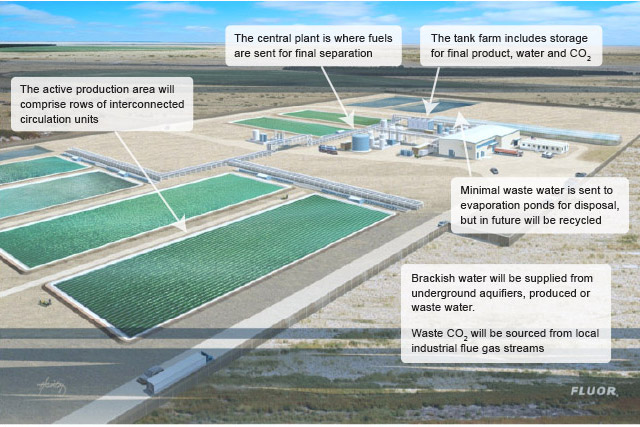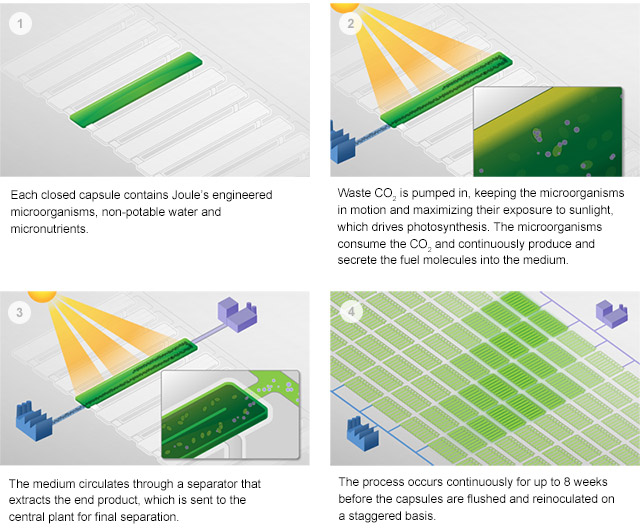This article was published at Breaking Energy, January 22, 2014 (.pdf)
Joule is a biotech firm developing a breakthrough photosynthesis based system for the production of liquid fuels using biocatalysts fueled by sunlight and carbon dioxide.
The Joule process looks like many of the algal biofuel processes from the outside, but under the hood it is completely different. If proven successful the Joule process could be a huge leap forward in productivity and efficiency. Most algal processes are based on growing algae biomass and squeezing oils out of them, or alternatively biomass conversion. These processes are limited by the growth rates of the algae just as any other biomass based process.
Joule’s process removes the biomass out of the equation and uses genetically modified bacteria to produce ethanol or hydrocarbons directly and continuously from the cells themselves. The bacteria are circulated through a series of tubes filled with water, nutrients and carbon dioxide exposed to sunlight. Over the course of the process the fuel product, be it ethanol, diesel, or other hydrocarbons are separated out in a continuous fashion. The racks of tubes are arranged in a modular fashion that allows one rack at a time to be cleansed of spent bacteria and reloaded while the rest of the production continues. After approximately eight weeks of production the bacteria are removed and incinerated and new bacteria are introduced into the system.
Among the advantages of the Joule system is the ability to use salt water or brine as the circulating agent, eliminating the need for clean fresh water. This lowers the costs and reduces the environmental impacts. The ability to use salt water opens up wide possibilities where facilities could be located, far away from agricultural lands or areas of water scarcity.
Joule uses carbon dioxide captured from industrial processes and so this process may prove to be a viable example of carbon capture and utilization. It is estimated that a 1000 acre plant could utilize 300,000 metric tons of CO2 annually.
The biggest advantage of the Joule system though, is the elimination of any biomass or the need to produce any crops. The biocatalyst bacteria are cultured in a lab in a controlled environment that is not dependent on weather or soil or any other vagaries of agriculture. There is also no requirement for costly and inefficient biomass conversion as the fuel product is directly produced from the cells themselves.
The heart of Joule’s system are prokaryotic cyanobacteria that use photosynthesis to grow. The scientists at Joule have modified the bacteria to produce hydrocarbons instead of cellular growth. Cyanobacteria are one of the oldest and most successful forms of life on Earth and are thought to be responsible for oxygenating the early atmosphere and helping to create the conditions for diverse life to flourish. Cyanobacteria are found in nearly every habitat and can flourish in a wide variety of conditions, a trait that has been harnessed by Joule and enables them to use brackish or salt water as a growth medium.
Joule’s first product is ethanol and they are also producing diesel fuel. By modifying the cyanobacteria Joule scientists are able to tailor the process to produce a variety of outputs. The ethanol product is called Sunflow-E and is chemically identical to ethanol on the market today. Sunflow-D, their diesel product is composed of diesel range, paraffinic alkanes and can be blended with conventional diesel in high concentrations of 50% or more.
Joule estimates annual commercial productions per acre of up to 25,000 gallons of ethanol at $1.28 per gallon and 15,000 gallons of diesel at $1.58 per gallon at full scale production. For comparison various agricultural crops produce ~300-800 gallons of ethanol per acre per year (ref: Wikipedia). Obviously production gains of this magnitude, if brought to fruition, could be transformative of the markets.
The company was founded in 2007 but operated in stealth mode for the first few years. An academic paper describing the process was published in 2011 and can be found here. It was around this time that the company came out of the closet and announced plans to construct their first demonstration facility in Hobbs, New Mexico. The Hobbs facility is one acre and is using brackish water from a local aquifer and waste CO2 captured from industrial flue gas that is piped to the plant.
The plant design is highly scalable and modular and can be readily expanded to thousands of acres. Joule is currently working on improving their systems engineering and proof of concept at their demonstration plant before moving on to full scale production.

